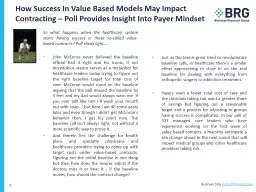

So what happens when the healthcare system starts having success in these socalled valuebased contracts Poll sheds light John McEnroe never believed the baseline official had it right and his iconic if not incredulous stance serves as a metaphor for healthcare leaders today trying to figure ID: 795506
Download The PPT/PDF document "How Success In Value Based Models May Im..." is the property of its rightful owner. Permission is granted to download and print the materials on this web site for personal, non-commercial use only, and to display it on your personal computer provided you do not modify the materials and that you retain all copyright notices contained in the materials. By downloading content from our website, you accept the terms of this agreement.
Slide1
How Success In Value Based Models May Impact Contracting – Poll Provides Insight Into Payer Mindset
So what happens when the healthcare system starts having success in these so-called value-based contracts? Poll sheds light....John McEnroe never believed the baseline official had it right and his iconic, if not incredulous stance serves as a metaphor for healthcare leaders today trying to figure out the right baseline target for total cost of care. McEnroe would stand on the baseline arguing that the ball missed the baseline by 3 feet and my dad would always warn me ‘if you ever talk like him I’ll wash your mouth out with soap…’ but here I am 40 some years later and even though I didn't get McEnroe's behavior then, I get his point now. The baseline call isn’t always right, not without a more scientific way to prove it.And therein lies the challenge for health plans and specialty physicians and healthcare providers trying to come up with target costs under value-based contracts. Figuring out the initial baseline is one thing but then how does the insurer adjust if the doctors miss it or beat it - if the baseline moves, how should the contract change?
Just as the tennis great tried to revolutionize baseline calls, in healthcare there’s a similar effort approaching to close in on the real baseline for dealing with everything from orthopedic surgery to addiction treatment. Payers want a lower total cost of care and the clinicians taking risk want a greater share of savings but figuring out a reasonable target and a process for adjusting to groups having success is complicated. In our poll of 321 managed care leaders who have experience working on the first wave of value based contacts, a majority anticipate a sea change ahead in the next round that will impact medical groups and other healthcare providers taking risk.
By Bryan Cote
bcote@thinkbrg.com
Slide2Slide3Analysis
A majority of payers expect they will need to – or try to – lower the baseline target cost in contracts if the average cost of care over an episode comes down. In one hypothetical scenario we posed, 73% say the baseline would be lower if the average cost for a surgical episode (e.g. orthopedic) went from $10,000 to $8,000. ‘Previous experience has shown that when you lower the cost of care, this usually becomes the new baseline’ according to several sources. 35%, however, believe that providers would likely get a higher share of savings if the baseline were reset like this and about half said that groups could avoid the reset if they are the only ones having success in a market. ‘We know not to drop the baseline too aggressively or the provider will not engage,’ one contracting professional opined. ‘A provider group should always look to have the baseline set at a regional peer level, so they will only have to perform better than their peers, not better than themselves.’ But the biggest payers may try to force a lower baseline and raise the share if needed, particularly if they have ‘other options’.
ConclusionsThe challenge for contracting teams is to avoid conflict but to keep trying to find the ‘floor’ – with orthopedics, the savings likely come from site of procedure shifts initially but then from effective rehab. With maternity, the savings likely come from good pre-natal care, depression screening to avoid pre-term labor, and of course C-section avoidance, but also effective post-partem services. United is doing this in a bundled pay model with Privia. With addiction, the episodes seem longer and the downside risk greater for both payer and provider. It’s a condition ‘being forced on the payer’ as one friend told me, so how do you develop achievable metrics and mechanically create an internal system for contracts (e.g. codes, payments, up and downside risk) that works for both sides. One answer may be in how far the insurer is ready to go to try new systems to solve the problem. Culturally, we know BCBS of North Carolina appears to be trying innovative things like risk contracts for addiction recovery. 3 and 5 year models where the provider, Eleanor Health, gets a per member per month and a share of savings or bonuses to get the patient to recovery may revolutionize payment for addiction and outcomes amidst an epidemic. But over time that baseline may need adjusting and the savings share may as well....so much so that if the players aren't careful and able to compromise, they may miss the point.